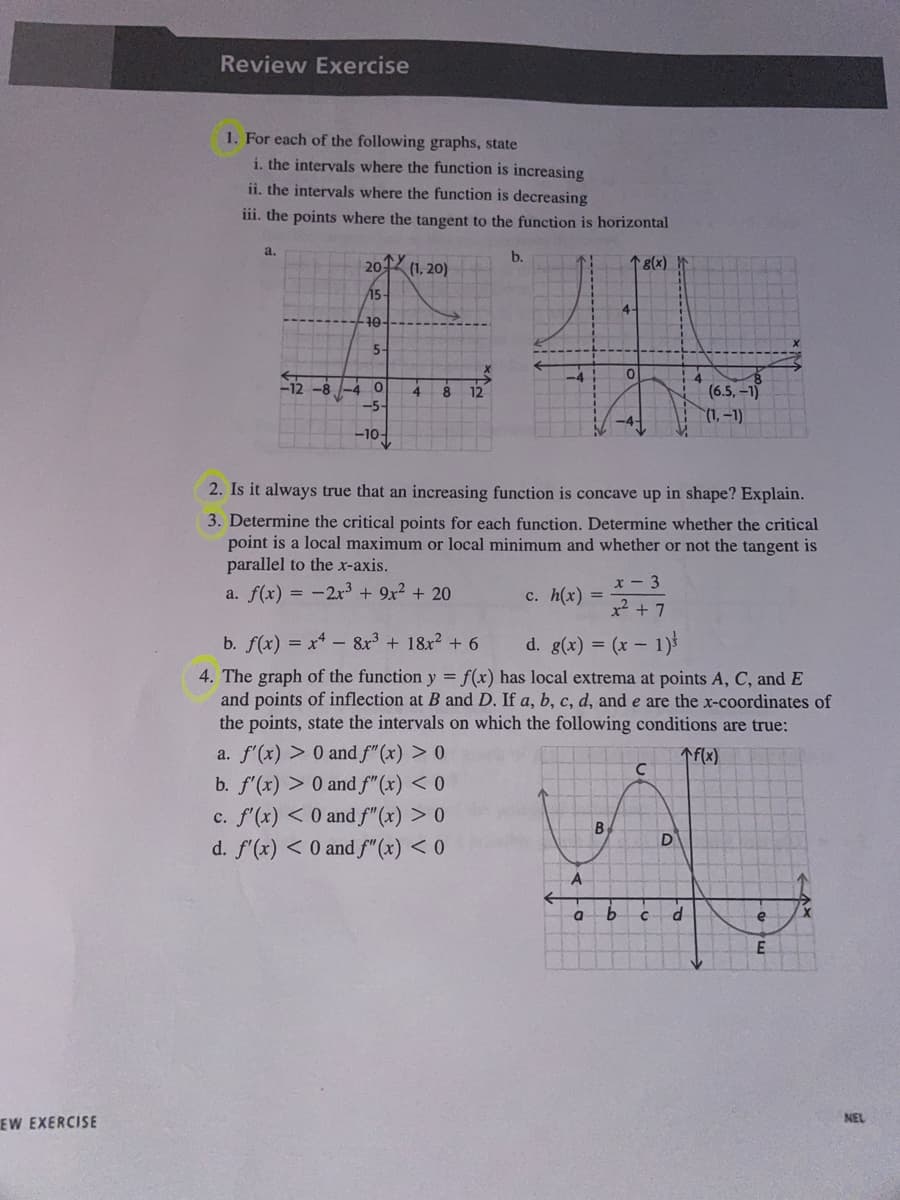1. For each of the following graphs, state i. the intervals where the function is increasing ii. the intervals where the function is decreasing iii. the points where the tangent to the function is horizontal a. b. 8(x)} 20 (1, 20) 115 40 5- 0 -12-8 12 (6.5, -1) (1,-1) -10 2. Is it always true that an increasing function is concave up in shape? Explain. 3. Determine the critical points for each function. Determine whether the critical point is a local maximum or local minimum and whether or not the tangent is parallel to the x-axis. a. f(x) = -2x³ + 9x² + 20 c. h(x) = x-3 x² + 7 b. f(x) = x4 - 8x³ + 18x² + 6 d. g(x) = (x - 1) 4. The graph of the function y = f(x) has local extrema at points A, C, and E and points of inflection at B and D. If a, b, c, d, and e are the x-coordinates of the points, state the intervals on which the following conditions are true: a. f'(x) > 0 and f"(x) > 0 ↑f(x) с b. f'(x) > 0 and f"(x) < 0 c. f'(x) < 0 and f"(x) > 0 d. f'(x) < 0 and f"(x) < 0 O -5- -T 4 A a B b с D d e E
1. For each of the following graphs, state i. the intervals where the function is increasing ii. the intervals where the function is decreasing iii. the points where the tangent to the function is horizontal a. b. 8(x)} 20 (1, 20) 115 40 5- 0 -12-8 12 (6.5, -1) (1,-1) -10 2. Is it always true that an increasing function is concave up in shape? Explain. 3. Determine the critical points for each function. Determine whether the critical point is a local maximum or local minimum and whether or not the tangent is parallel to the x-axis. a. f(x) = -2x³ + 9x² + 20 c. h(x) = x-3 x² + 7 b. f(x) = x4 - 8x³ + 18x² + 6 d. g(x) = (x - 1) 4. The graph of the function y = f(x) has local extrema at points A, C, and E and points of inflection at B and D. If a, b, c, d, and e are the x-coordinates of the points, state the intervals on which the following conditions are true: a. f'(x) > 0 and f"(x) > 0 ↑f(x) с b. f'(x) > 0 and f"(x) < 0 c. f'(x) < 0 and f"(x) > 0 d. f'(x) < 0 and f"(x) < 0 O -5- -T 4 A a B b с D d e E
Algebra & Trigonometry with Analytic Geometry
13th Edition
ISBN:9781133382119
Author:Swokowski
Publisher:Swokowski
Chapter5: Inverse, Exponential, And Logarithmic Functions
Section5.1: Inverse Functions
Problem 56E
Related questions
Question

Transcribed Image Text:EW EXERCISE
Review Exercise
1. For each of the following graphs, state
i. the intervals where the function is increasing
ii. the intervals where the function is decreasing
iii. the points where the tangent to the function is horizontal
a.
2014
(1, 20)
↑ 8(x)
15-
4-
10
40
5-
0
4
8
-5-
(6.5, -1)
(1,-1)
-10-
2. Is it always true that an increasing function is concave up in shape? Explain.
3. Determine the critical points for each function. Determine whether the critical
point is a local maximum or local minimum and whether or not the tangent is
parallel to the x-axis.
x-3
a. f(x) = -2x³ + 9x² + 20
c. h(x)
x² + 7
b. f(x) = x4 - 8x³ + 18x² + 6
d. g(x) = (x - 1)
4. The graph of the function y = f(x) has local extrema at points A, C, and E
and points of inflection at B and D. If a, b, c, d, and e are the x-coordinates of
the points, state the intervals on which the following conditions are true:
a. f'(x) > 0 and f"(x) > 0
↑f(x)
C
b. f'(x) > 0 and f"(x) < 0
c. f'(x) < 0 and f"(x) > 0
d. f'(x) < 0 and f"(x) < 0
-8
A
a
B
b
с
D
d
e
E
NEL
Expert Solution
This question has been solved!
Explore an expertly crafted, step-by-step solution for a thorough understanding of key concepts.
Step by step
Solved in 3 steps

Recommended textbooks for you

Algebra & Trigonometry with Analytic Geometry
Algebra
ISBN:
9781133382119
Author:
Swokowski
Publisher:
Cengage

Big Ideas Math A Bridge To Success Algebra 1: Stu…
Algebra
ISBN:
9781680331141
Author:
HOUGHTON MIFFLIN HARCOURT
Publisher:
Houghton Mifflin Harcourt

Algebra & Trigonometry with Analytic Geometry
Algebra
ISBN:
9781133382119
Author:
Swokowski
Publisher:
Cengage

Big Ideas Math A Bridge To Success Algebra 1: Stu…
Algebra
ISBN:
9781680331141
Author:
HOUGHTON MIFFLIN HARCOURT
Publisher:
Houghton Mifflin Harcourt